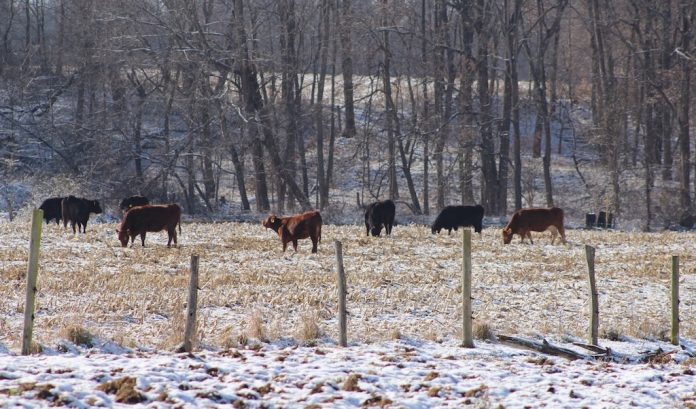I knew it would happen. It does every year. I wasn’t expecting it so soon. It kind of snuck up on me. Snow is on the ground, and the cattle want to eat. They never seem to take a snow day.
I know the snow won’t stick around for long, but there will be more to follow. Eventually it will stick around for days or maybe even weeks.
Over the years, I’ve recommended many strategies for feeding cattle in the snow. For those of you who have been in the business for a while, this might be old hat. You’ve learned your lessons. Others may still be learning. Either way, here are a few thoughts to ponder as we enter the winter months.
Snow grazing
The first thing to know is that cattle can find grass under the snow. Even if you have more than a foot on the ground, they can still dig through and find it.
If you have stockpiled your forages to graze this winter, then go ahead and rotate the cattle through your fields as you normally would. You might move them a little more often because the ground is wet. The cattle may tear up the ground more quickly and make it harder for the pasture to recover. If you need to, rotate them back through the pasture in a few weeks.
Hay rings
If you are feeding hay, there are a couple of options. The old standby is to put the hay in a hay ring and walk away.
For those who have been around for a while, it doesn’t take long to learn that cattle can tear up a wet field and leave it a muddy mess. If using a hay ring is your strategy, it is recommended that you move the ring on a regular basis and allow the field to recover. This also helps spread the manure around without much added labor.
Unrolled hay
Another option for feeding hay is to unroll it in the field. This has the advantage of allowing you to roll out the hay in a different location every time. The result is that the nutrients deposited by the cattle are spread around the pasture. You will also have the added benefit of not spending money on a hay ring.
The downside is that this can lead to a lot of waste as the cattle roam across the hay. Once it gets wet and muddy, they aren’t eating it. The best way to minimize the waste is to put a temporary hot wire down the middle of the row. This will allow the cattle to eat from one side without going back and forth across it.
From experience, I would recommend having the hot wire set and rolling the hay out next to it. You can then move your step-in post to the middle after its unrolled. Either that, or keep the cattle out of the field until you have it set up.
Unrolling may not be ideal, but it does give you a feeding option, and I have seen some cattle really do well. This is especially true if you are feeding many cattle. They eat it quickly, and they don’t start bedding on it.
Heavy use pads
A final option would be to upgrade your facilities with a heavy use pad. Yes, this can be expensive, but it may save you some hassle in the years to come and save your fields. It also gives you the added advantage of storing manure and spreading it on the fields under more favorable conditions.
Check with your local Natural Resources Conservation Service office. There may be some EQUIP funds available to help defray the cost. Of course, it won’t help this year, but it’s never too early to start planning for next year.
Water
A discussion about feeding in the snow would never be complete without mentioning water. No matter what method of feeding you use, the cattle will always need water. Make sure that its available and not frozen, especially if you are rotating them through your stockpiled forages.
Of course, this could be a whole other discussion on watering in the winter, but I will leave that for another time. As the snow is starts to fly, make a snow feeding plan that will work for you, your fields and your cattle.
A little planning now will save you headaches in the future. You’ll thank me next year when you don’t have to do pasture renovation. Now, it’s time to feed the cows and try to stay warm.













